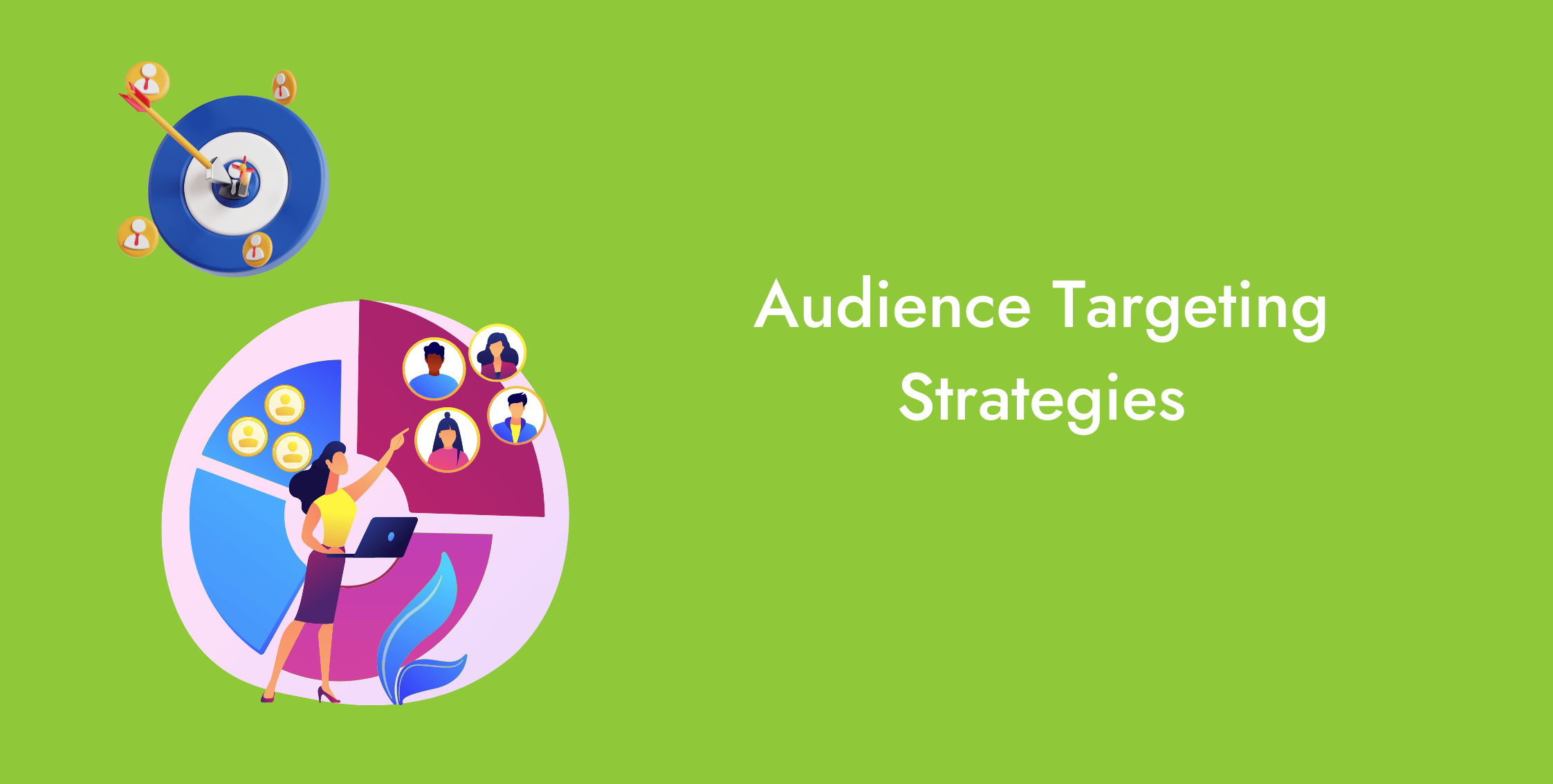Have you tried different marketing approaches without landing on target? Try audience targeting.
Knowing who might be interested in your product or service is integral to a successful campaign.
Finding the right audience at the right time and the willingness to pay can make or break everything for businesses.
Read along to find the best audience-targeting strategies to improve click-through rates and conversions.
What is Audience Targeting?
Audience targeting is identifying specific audience segments most likely to use your products or services according to various criteria and aiming your marketing efforts at them.
Understanding the target audience helps marketers tailor their content and advertisements to their needs.
This approach ensures that the marketing efforts land where they are bound to give results, driving traffic and moving people along the conversion funnel.
It saves you the hassle of wasting ad spend on audiences not interested in your products or services.
Our Top Audience Targeting Strategies
Audience targeting involves segmenting people into groups of similar patterns and interests. Then, come up with digital marketing campaigns to encourage them to convert.
Audiences respond well to custom marketing tailored to their needs and likings.
Our targeting strategies include the best practices for finding the right audiences and speaking to them in a language they appreciate and respond to.
1. Demographic Audience Targeting
One of the first things to consider for your audience targeting is to look for the relevant demographic.
Typical demographic aspects considered to narrow the audience include age, gender, geographic location, and income group.
It can mean different things for different businesses and even marketing channels.
For example, if you aim your product at mid-career managers, your demographics of interest can include 28 and 38-year-old managers in small to medium-sized companies.
Other demographics can include a particular city or region where you offer services.
Demographics also comes into play when optimizing different channels for marketing.
For example, the audience on Instagram is younger.
Also, Instagram is a picture-based medium. Using aesthetic, eye-catching, quirky content for this channel makes sense.
Twitter has a younger audience, and the format is short and quick.
It is an excellent medium for creating hype by releasing teasers and hashtags and encouraging followers to retweet.
If you have any queries about our services, get in touch. Our team of highly qualified professionals will take care of your woes.
2. Psychographic Audience Targeting
Knowledge about the demographic mix of your audience alone does not cut it.
A psychographic marketing strategy considers the feelings, affinities, values, interests, and goals in deciding how and whom you target.
A consumer’s emotions right before they decide to buy a product or service play a pivotal role in conversion.
For example, you are an athleisure clothing brand. Your audience consists of fitness-conscious individuals.
You create a fitness community for your users where fitness trainers, nutritionists, and other experts write guest posts.
Through interactions, you find that a considerable segment of your audience is environment-conscious.
You can use this information to introduce green textiles or recycled materials into your clothing line.
Or partner with an exclusive organic food manufacturer for your audiences to buy healthy meals at a discounted rate.
Or you offer a basic plan for a free software product and a paid upgrade.
Knowing the analysts at the right seniority level, preferring functionality over money, can help you find the audience you can upsell to.
3. Competitor Analysis for Audience Targeting
Market research is part and parcel of an effective marketing strategy.
Competitor analysis is fundamental to effective market research and serves as a guiding light in audience targeting.
You compete for nearly similar audience segments.
Knowing what works and does not work for your competitors can help you avoid pitfalls and implement best practices to increase your market share.
Tools like SEMRush and Buzzsumo help you analyze your competitors’ website ranking, SEO performance, and engagement.
Learn your lessons and implement a befitting content strategy for your target audiences.
4. In-Market Audience Targeting
An audience that does not necessarily engage with or is familiar with your product or service but is actively looking for something similar is the in-market audience.
They are a gold mine of untapped potential with a high purchase intent.
Interested people enter relevant keywords in search engines like Google, looking for products or services. Then, they visit sites, click ads, and get converted.
Google uses its internal criteria to qualify these individuals as an in-market audience.
When you choose in-market audience targeting for your Google ads campaign, Google shows these ads to the highly qualified audience segment.
Capitalize on the in-market audience targeting by using personalized messaging and addressing the pain points to drive conversions.
5. Buyer Personas for Audience Targeting
A buyer persona is the ideal customer for your business constructed by volumes of data generated by market research, consumer analysis, and expert input.
It is created by pooling demographic and psychographic data. You can do the following things to analyze your audience's interest.
- Review User attributes in your Google Analytics 4 property.
Learn how you can use GA4 for geo-targeted advertising campaigns.
- Check Facebook Audience Insights to learn about your audience demographics, interests, and lifestyles.
- Use Twitter Analytics to find the content your audiences engage with and their top ten interests.
- Find the topics and queries your website is found for via Google Search Console to learn about user interests.
- Create surveys and scan your social media communities to look for topics of interest.
Using these inputs, create a few buyer personas for each stage.
They help you understand who your customers are, their challenges, and how you can offer a solution to them.
The market is dynamic and constantly changing. Your buyer persona should do the same.
Keep feeding new data, market trends, and shifting interests to update your buyer personas.
6. Contextual Audience Targeting
Why place ads where the user may have gone for a different intent?
Contextual targeting solves the issue by displaying your ads on websites with relevant content, offering better personalization.
Instead of designing the entire marketing strategy around user behavior, contextual audience targeting approaches a more receptive audience.
A person visiting a website whose content aligns with the text, semantics, or keywords in your ad is more likely to click on it.
It is the next best thing in a post-cookie tracking world where user data privacy can make it difficult for marketers to find the right audience.
Don’t believe us? The global market for contextual advertising was estimated to be around $199.8 billion, with predictions of over 13.8% from 2022-2023.
7. Social Listening
Identifying and assessing what people are saying about a product, service, brand, or company on social media is called social listening.
It has three distinct steps.
- Social media monitoring
- Analysis
- Response
Monitoring
All businesses engage in social media monitoring by regularly checking their social media.
They look for their brand mentions, competitors, keywords, topics, and products mentioned in social conversations.
Analysis
It involves using social media tools like Hootsuite to mine the keywords and text on social media to perform actions like sentiment analysis, trend analysis, and competitor analysis.
Response
Finally, choose your response to the customer's comment, concern, or sentiment.
You may respond directly to a comment they tagged you or reposition your business to address the issue.
You can integrate social listening as an audience-targeting strategy to position yourself as a business that cares for its customers.
Also, knowing what your customers value can help you refine your campaign strategies, build deeper relationships with them, and find new business opportunities.
8. Smart Targeting
Smart targeting for ad campaigns involves the use of AI data analytics and insights to deliver personalized advertisements to specific audience segments.
It goes beyond reliance on descriptive data analysis and relies on predictive and prescriptive analysis to create better audience segments based on their interests instead of their activity.
You can also use AI and ML-powered data analytics to identify the platforms (web, social media, mobile apps) and sort of ads that interest your audience segments.
Then create tailored ad copies and use inputs from first-party and data management platforms (DMPs) to monitor their performance in real time and optimize them for better results.
9. A/B Test Your Ad Campaigns
What better way to test if your marketing campaigns are effective for specific audience segments than performing A/B testing on your ad campaigns?
Audience targeting is about splitting your audiences into segments, understanding them, and approaching them with personalized messaging.
With A/B testing, you can find out what works best and results in more clicks, engagement, and conversion.
Simply switch a single variable in your campaign and show one version to one half of the audience and another to the other half.
Test both versions simultaneously and plug in an appropriate A/B testing tool to analyze your results and implement the one with statistically significant better results.
Conclusion
Audience targeting is identifying and marketing your product or service to a segment most likely to use them.
Our top audience targeting strategies include demographic and psychographic targeting.
Competitor analysis, in-market audience targeting, contextual targeting, building buyer personas, employing social listening, and A/B testing are some of our favorites.
Demographic audience targeting means identifying and targeting your audience based on age, gender, geographic location, sex, and income group.
The psychographic strategy targets the audience based on emotions, values, affinities, and goals.
You may use Google Ads features like in-market audience and contextual targeting to deliver more personalized ads.
In-market audience compromises the people actively looking for products or services similar to yours. Contextual targeting, on the other hand, displays ads on websites with relevant content.
Building a buyer persona and creating campaigns to solve their issues is an excellent time-tested approach.
Keep tabs on your competition with competitor analysis to see what works and does not work from them and apply the lessons.
Learn what people are saying about your business with social listening and use that to build campaigns that resonate with them.
Finally, integrate A/B testing into your audience targeting strategies to find what works best and apply it website-wide.
Like what you read? Learn more about Digital Analytics on our blog here.


